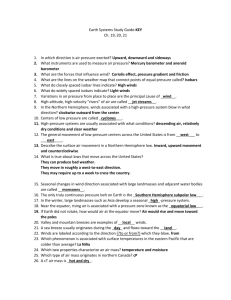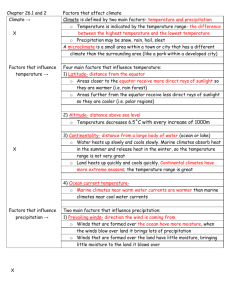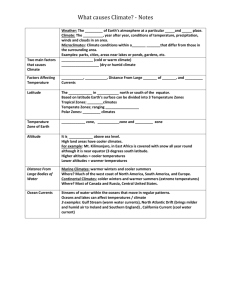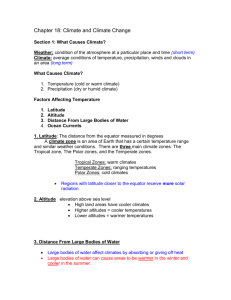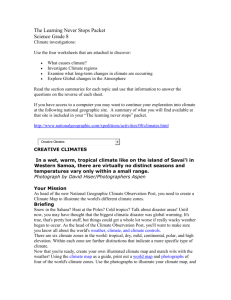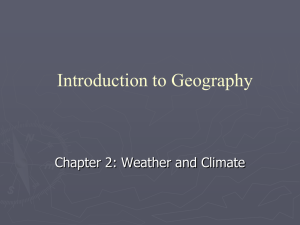File
advertisement
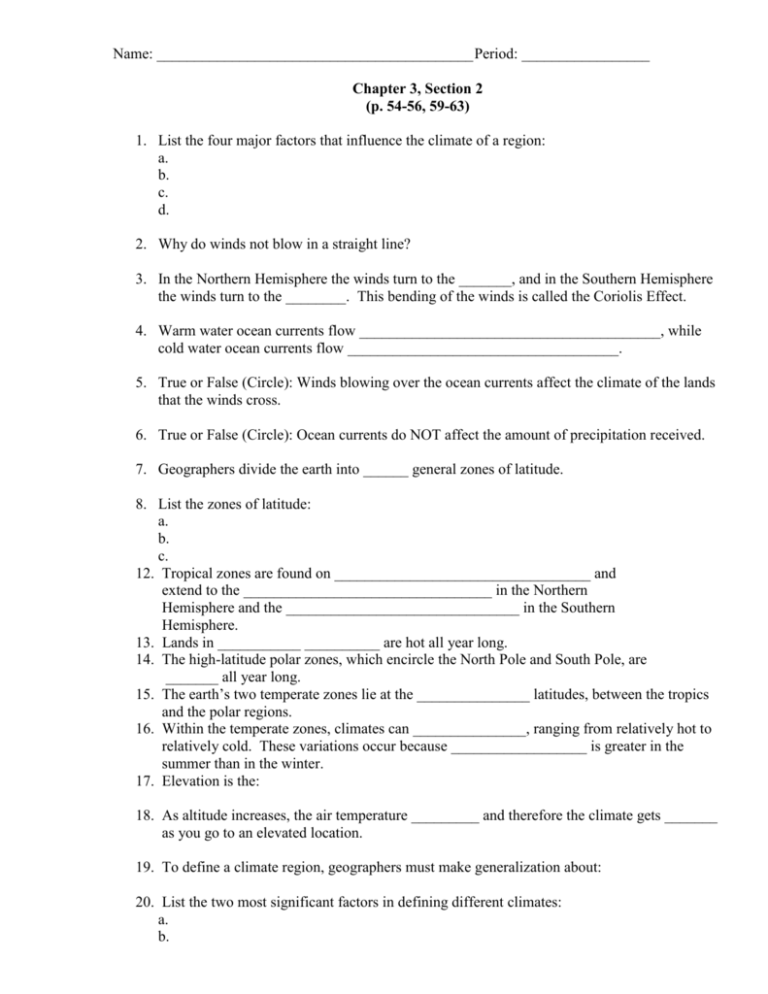
Name: __________________________________________ Period: _________________ Chapter 3, Section 2 (p. 54-56, 59-63) 1. List the four major factors that influence the climate of a region: a. b. c. d. 2. Why do winds not blow in a straight line? 3. In the Northern Hemisphere the winds turn to the _______, and in the Southern Hemisphere the winds turn to the ________. This bending of the winds is called the Coriolis Effect. 4. Warm water ocean currents flow ________________________________________, while cold water ocean currents flow ____________________________________. 5. True or False (Circle): Winds blowing over the ocean currents affect the climate of the lands that the winds cross. 6. True or False (Circle): Ocean currents do NOT affect the amount of precipitation received. 7. Geographers divide the earth into ______ general zones of latitude. 8. List the zones of latitude: a. b. c. 12. Tropical zones are found on __________________________________ and extend to the _________________________________ in the Northern Hemisphere and the _______________________________ in the Southern Hemisphere. 13. Lands in ___________ __________ are hot all year long. 14. The high-latitude polar zones, which encircle the North Pole and South Pole, are _______ all year long. 15. The earth’s two temperate zones lie at the _______________ latitudes, between the tropics and the polar regions. 16. Within the temperate zones, climates can _______________, ranging from relatively hot to relatively cold. These variations occur because __________________ is greater in the summer than in the winter. 17. Elevation is the: 18. As altitude increases, the air temperature _________ and therefore the climate gets _______ as you go to an elevated location. 19. To define a climate region, geographers must make generalization about: 20. List the two most significant factors in defining different climates: a. b. 22. What is the most common method to describe climate patterns? 21. List the five general climate regions: a. b. c. d. e. 23. The TROPICAL WET sub region is always ______ and rain falls almost _________. Tropical wet climates are found in __________________________ ___________________________________________. 22. The TROPICAL WET AND DRY climate is so named because the sub region has a ________________________________________________________. Tropical wet and dry climates are found next to topical wet climates in ________________________________________________. 23. The SEMIARID climate sub region does receive precipitation, just not very much. Summers are ________ and winters are ________________. The climate is found _____________________________________________ and some around deserts. 24. This sub region contains some of the most productive agricultural lands in the world: _______________________ 25. Deserts are categorized according to the amount of ____________ and can be _____ or _______. Deserts receive less that ____ inches of rain per year. 26. What is the Mediterranean climate named after? 27. Describe the Mediterranean climate: 28. Marine West Coast climate is frequently ________, __________ and _________. 29. True or False (circle): Marine West Coast is located far away from the ocean. 30. Precipitation in marine west coast climate regions is ______________________ ___________________ throughout the year. 31. What characterizes the Humid Subtropical climate? 32. Humid Subtropical climates are found on the east coast of continents and are often subject to ___________________. 33. A great variety in temperature and precipitation characterizes the _____________ _______________________ climate, which is found in the mid-latitude interiors of Northern Hemisphere continents. 34. Evergreen forests called _________ cover the lands in the ____________ sub region. 35. In the SUBARTIC region the winters are always very ________________. 36. Write the definition of TUNDRA: _____________________________________ _______________________________________________. 37. The tundra is almost exclusively located in the ____________________ hemisphere. 38. The tundra has ______________________________, land that is constantly frozen. 39. Snow, ice, and permanently freeing temperatures characterize the ____________ region, which is so cold that is rarely snows. 40. The ___________________________ climate caries with latitude, elevation, other topography and continental location.


